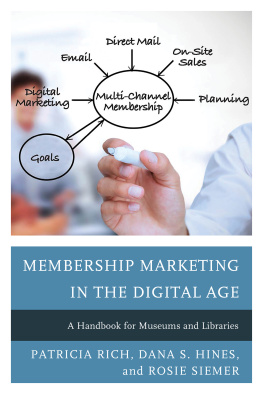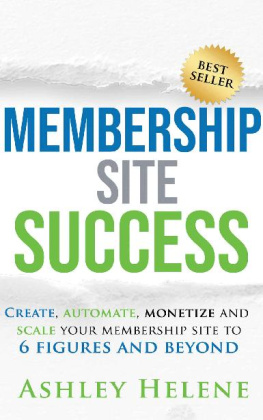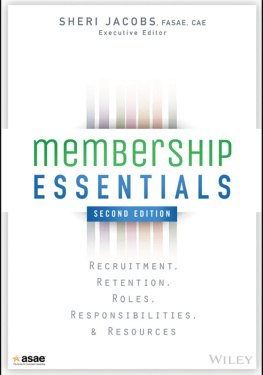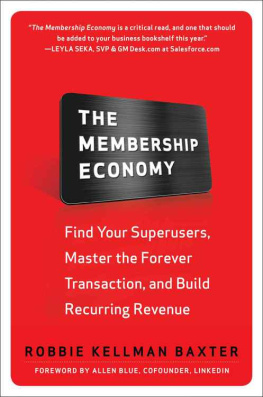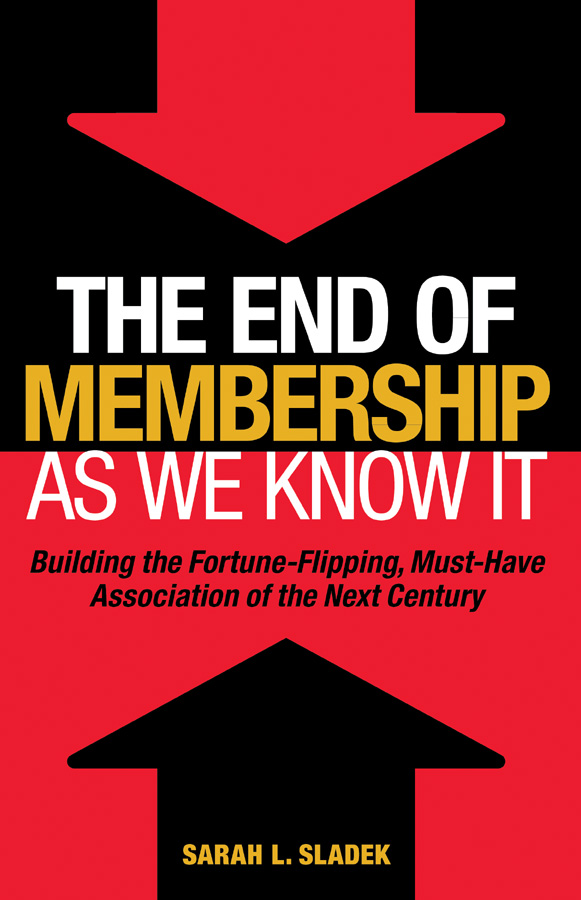Contents

The author has worked diligently to ensure that all information in this book is accurate as of the time of publication and consistent with standards of good practice in the general management community. As research and practice advance, however, standards may change. For this reason it is recommended that readers evaluate the applicability of any recommendations in light of particular situations and changing standards.
ASAE: The Center for Association Leadership
1575 I Street, NW
Washington, DC 20005-1103
Phone: (202) 626-2723; (888) 950-2723 outside the metropolitan Washington, DC area
Fax: (202) 220-6439
Email:
We connect great ideas and great people to inspire leadership and achievement in the association community.
Keith C. Skillman, CAE, Vice President, Publications, ASAE: The Center for Association Leadership
Baron Williams, CAE, Director of Book Publishing, ASAE: The Center for Association Leadership
Cover and interior by Troy Scott Parker, Cimarron Design
This book is available at a special discount when ordered in bulk quantities. For information, contact the ASAE Member Service Center at (202) 371-0940.
A complete catalog of titles is available on the ASAE website at www.asaecenter.org .
Copyright 2011 by ASAE: The Center for Association Leadership. All rights reserved.
ISBN-13: 978-0-88034-343-5
ISBN-10: 0-88034-343-5
Permission to reproduce or transmit in any form or by any means, electronic or mechanical, including photocopying and recording, or by an information storage and retrieval system any portion of this work must be obtained in writing from the director of book publishing at the address or fax number above.
To my bright and beautiful daughters who, by their very existence, make me want to make the world a better place. Every day is an adventure, every dream a possibility.
And to my mentor, Jeff Leitner, for keeping me focused on shooting hoops instead of hitting fly balls. You are annoyingly right about everything and you challenge me more than anyone else and Im grateful for that.
Chapter 1
The Making of a Dominant Association
Prosperity tries the fortunate; adversity the great.
Rose F. Kennedy
After a boom on the stock market that enticed many everyday people to invest their entire savings, the stock market crashed on October 29, 1929. The crash marked the beginning of a decade of high unemployment, poverty, low profits, deflation, plunging farm incomes, and lost opportunities for economic growth and personal advancement. Although its causes are still uncertain and controversial, the net effect was a sudden and general loss of confidence in the economic future. Americas economy was at an all-time low, slumping into the Great Depression, followed by World War II.
Times were tough, but recovery soon followed. In 1946, the war was over, the economy was thriving, and the first Baby Boomers were born. Their parents would encourage them to attend college, work hard, raise families, and pursue the American Dream. This generation would be raised to give generously of their time and money to community organizations and causes. The Baby Boomer generation would become passionate about joining, volunteering, and serving membership associations.
While membership associations have been in existence since the 1600s, we can look back in history and see that the time between 1946 and 2000 were stand-out years for most associations. The active support of the Boomers, the largest generation in American history, coupled with the participation of their predecessors, the Traditional Generation, membership associations thrived. We can even go so far as to say that membership associations dominated both the professional and personal social structures.
In economics, a monopoly exists when an enterprise has sufficient control over a particular product or service to determine the terms under which other individuals shall have access to it. Monopolies survive when there is a lack of economic competition. For years, membership associations were in many ways like monopolies, dominant in our culture; they offered a valuable commodity, members paid dues to have access to the commodity, and competition was minimal.
From 1995 to 2000, stock markets in industrialized nations saw their equity value rise rapidly from growth in the evolving internet sector. The period was marked by the founding of a group of new internet-based companies commonly referred to as dot-coms. A combination of rapidly increasing stock prices, market confidence that the companies would turn future profits, individual speculation in stocks, and widely available venture capital created an environment in which many investors were willing to overlook traditional metrics in favor of confidence in technological advancements.
Yet, as the saying goes, what goes up must come down. Starting in 2000, associations would experience a barrage of challenges that would weaken their positions in the marketplace and forever alter their futures. Eventually, the bubble burst. In just six daysfrom March 10 to March 15, 2000the NASDAQ lost nearly nine percent. Hiring freezes, layoffs, and consolidations followed in several industries.
On September 11, 2001, terrorists attacked New York and Washington DC, intentionally crashing two airplanes into the World Trade Center and another into the Pentagon. A fourth plane crashed into a field after the crew and passengers tried to retake control of the plane. In the aftermath of this tragic day, many associations suffered substantial losses in meeting and event attendance and were forced to not only consider new options for delivering content and value to members but also become a resource to help their members through these tragic times.
On October 6, 2008, the Great Recession began. The stock market spiraled into a week-long decline in which the Dow Jones Industrial Average fell 18.1 percent. The financial crisis was triggered by a liquidity shortfall in the United States banking system and resulted in the collapse of large financial institutions, the bailout of banks by national governments, and downturns in stock markets around the world.
For the United States in particular, persistent unemployment, the continuing decline in home values, an escalating federal debt crisis, inflation, and rising gas prices continue to plague the country at the time this book is being written in 2011.
On January 1, 2011, Americas organizations braced themselves for the retirement wave. For years our nations leaders have been concerned about the arrival of 2011. Its long been predicted that this will be the year that launches our nations enterprises into a downward spiral composed of retirement waves and talent turnover. Some have even referred to it as the perfect storm that will leave organizations at risk of losing critical knowledge and unable to fill valuable positions vacated by the Boomers.
The Great Recession may have softened the blow that was once expected, as some Boomers opt to postpone their retirements. Nonetheless, this year alone, 2.8 million Americans will turn 65. Between now and 2030, 78 million Boomers will retire, which marks the beginning of the end of the workforce as we have known it.
Looking Forward
Will this decade of economic catastrophe lead to decades of prosperity? Perhaps were on the brink of another economic boom, and just as America once evolved from a country plagued with economic depression and war in the 1930s and 1940s, America will prosper again. Perhaps not.



